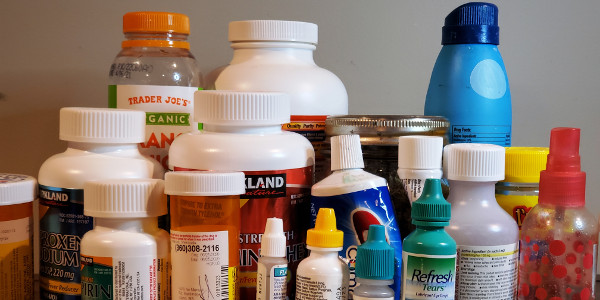The Knurled World
Lately, I’ve been seeing knurls everywhere. You know, those vertical ridges on bottle tops, toothpaste caps, and lids. At first I didn’t even know what they were called. But out of a dark corner of some unidentified gyrus of my cerebral cortex, I heard a shy, tentative peep say ‘knerl,’ or something like that. I of course Googled it, and was eventually led to “knurl,” which was defined as “a small projecting knob or ridge, especially in a series around the edge of something.” Bingo, I found it! I then spent (or, you might well argue, wasted) many hours scouring the web for “knurl” and “knurling.” Thus, I was introduced to the knurled world.
As the first article I read put it, “Knurling can enhance the aesthetics of a product by introducing an attractive pattern to its surface. Most people will agree that textured finishes are more attractive than smooth finishes.” Already my mind was spinning! Is it really true that most people agree that textured finishes are more attractive than smooth surfaces? That never occurred to me. Though, since no references were cited, perhaps the knurled enhancement of aesthetics is obvious–especially to anyone who knows their knurls. And certainly to anyone who sells knurling machines, of which, as I soon found out, there are many.
The article went on, “Aside from aesthetics, though, there are practical reasons for manufacturing companies to perform knurling. Products that require gripping, such as hand tools, are often knurled to improve their performance and usability…Knurling protects against hand slippage by creating a textured pattern that’s easier to grip.” I found that statement easier to accept than the aesthetics one. But, curiously, though the learned articles as well as the purveyors of knurling machines all state that knurled surfaces are easier to grip than smooth ones, not a single one explains why this is so.
All I could come up with was this: when we grip a knurled surface, the skin of our fingers, along with the various layers of underlying tissue, press into the spaces between the raised portions of the knurl. Then, when we squeeze, we’re applying lateral pressure to the sides of the knurled valleys. That is, we’re pressing our flesh against the adjacent ridges. This provides additional force over what we could apply by gripping a smooth (and less aesthetically pleasing) surface.
Here’s a little thought experiment which, at least to me, proves the importance of our finger tissues getting down into the grooves: Pretend that the skin overlying our fingers is totally smooth and totally non-pliable, like, for example, the metal hand of a robot. If R2-D2 applied the same amount of squeezing force to the toothpaste cap as we do with our fingers, imagine how much harder it would be for him to open it—his robotic digits would likely just slide over the knurling without getting a good grip. And if his smooth fingers squeezed it tightly enough to unscrew it, the cap would run the risk of cracking. I guess it’s a good thing that R2-D2 has no teeth to brush!
When you think about it—or at least when the author of the Wikipedia “Knurling” article thinks about it–knurls are everywhere: the author cites the knurling found on tool handles, mechanical pencils, barbell bars, pistol grips, control knobs, darts grips, surgical instruments, and even the foot pegs of BMX bicycles. And it doesn’t stop there: consider, for example, the “knurled nut,” found so commonly on small diameter bolts, electronic components, musical instruments, and automobiles, to name a few. I suspect that it would be extremely difficult to get through even a single day without interacting with multiple examples of knurling.
So where, you are almost certainly wondering by now, did the word “knurl” come from? Well, that’s easy. Once again, Wikipedia to the rescue: “The terms knurl and knurled are from an earlier knur ‘knot in wood’ and the diminutive -le, from Middle English knaur or knarre ‘knot in wood; twisted rock; crag’. This descends from Old English cnearra but the vowel in Middle English may have been influenced by Old Norse knǫrr ‘merchant ship’ which was known as cnearr in Old English.” You may protest that this is a little abstruse. But not so fast—when you press your fingers against the knurling on the toothpaste cap as you brush your teeth in the morning, simply think of ‘knot in wood’ while visualizing a Norse merchant ship; if you do so you’ll never forget the derivation.
A study of knurls naturally leads to the world of knurling machines. Among other patterns, it turns out that knurling machines can produce “annular rings”, “linear knurls”, “rolled knurls”, and “diamond knurls”, as well as the quotidian “straight knurls”. After explaining the basics of knurling machines, an online article goes on to tackle a common misconception: “A popular myth is that rolled knurls are somewhat more complicated to design than cut knurls because the outer diameter of the workpiece must be chosen to allow the roller to roll an integral number of patterns around the workpiece; in practice if the knurl is applied positively, it will engage with its own impression and create a proper knurl on any diameter of work.” I feel fortunate that I’ve been disabused of my belief in the popular myth of the difficulty of designing rolled knurls which, I must confess, I shared.
As is true in other manufacturing fields, purveyors of knurling machines are eager to be green as well as to reduce costs. One site selling knurling machines acknowledges these considerations by suggesting that “specifiers and procurement agents can shave costs by playing with the closure design, process, or grade of material.” Specifically, “knurl reduction” is advocated. Here’s what they suggest: “You can reduce the amount of material in knurls by increasing the distance between the knurls, reducing the width of knurls or by having different patterns—like each alternate knurl can be cut in size by half. Typically, the weight contribution of knurls in the gross weight of a cap is 20% of the total weight. Even a 50% decrease in this would cut the material weight of cap by 10%.” Sure sounds to me like knurl reduction is the way to go!
In the competitive world of knurling machines, it appears that Shandong Lipeng Co, Ltd is at the top of the heap. Their specialty is manufacturing the knurling machines that produce knurled bottle caps. Their machines can crank out an astounding “30,000pcs/8h.” That’s a lot of knurling going on! It’s clear that Lipeng takes its mission seriously—their website tag line is, “Bottle cap is small, but it is still an art work~.” I guess this is another example of knurlers’ belief that their products have aesthetic value–I’ll certainly try to look at the next knurled bottle cap I encounter as the work of art it surely is.
But there’s more. The Shandong site continues, “Shandong Lipeng Co., Ltd has been carrying the sacred mission to create a leading brand in bottle cap line around the worldwide. Keeping persueing perfect & establishing the uncopied central competitive power to enjoy the reasult as small pieces, huge market. We have the enrich facilities for production and we also take granted to our expert R&D center…” Perhaps their English isn’t expert (though it’s a heck of a lot better than my Mandarin), but their comprehensive knowledge of–and passion for–knurling clearly is! It’s humbling to appreciate the expertise, zeal, and sense of mission that the knurling community brings to its craft. Perhaps it’s a model for us all, no matter what our work.
In addition to a much more profound knowledge of the field, my deep dive into knurls and knurling has shown me how oblivious we can be to what’s everywhere around us. I marvel at how many features of our world, in addition to knurls, that we see but aren’t conscious of. Among the things I’ll try to be more aware of are: the multitude of knobs and handles that we use in the course of a day, the ubiquity of right angles in objects constructed by humans (and their virtual absence in nature), the pervasiveness of some shade of the color green just about anywhere you look, and the interaction of all the ambient sounds that, if we really listen, can be heard at one time. And, who knows, maybe even the immanence of God.




The world is a “knurly” place…
Now that’s all I’m seeing! Thanks for encouraging us to be more mindful!
You help me see the world in new ways, Papa. 🙂 This is my “something new” learned for the day.
Ken, You’ve managed to include a potpourri of relationships in this “knurlish” essay: R2-D2, Norse merchant ships, and God! An amazing mixture that made me think of that Disney tune, “It’s a World of Wonder”- except now I’m singing (to myself) “It’s a World of Knurls.”
When I saw the image and the title, I assumed that “knurled” was a euphemism for “completely, irrevocably screwed”–as in, “look at all these things that are choking our oceans and piling up in landfills! Our world is totally knurled!
What a great study as we were hurling into knurling! I had no idea there was such a meticulous science to the width of the knurls. The patterns indeed seem almost as varied as knits-and-purls, which could leave one in stitches over knurls.
Your description of the creases of our fingers being pressed into the creases of the knurls reminded me how i dislike opening bottles with knurled tops. It seems that I get temporary numbness from pressing firmly to try to open them!
Perhaps this is only a problem for knarled versus gnarld fingers. Or knurled fingers? Either one is rough! And to think their mission is sacred!
Thanks for this, Ken!